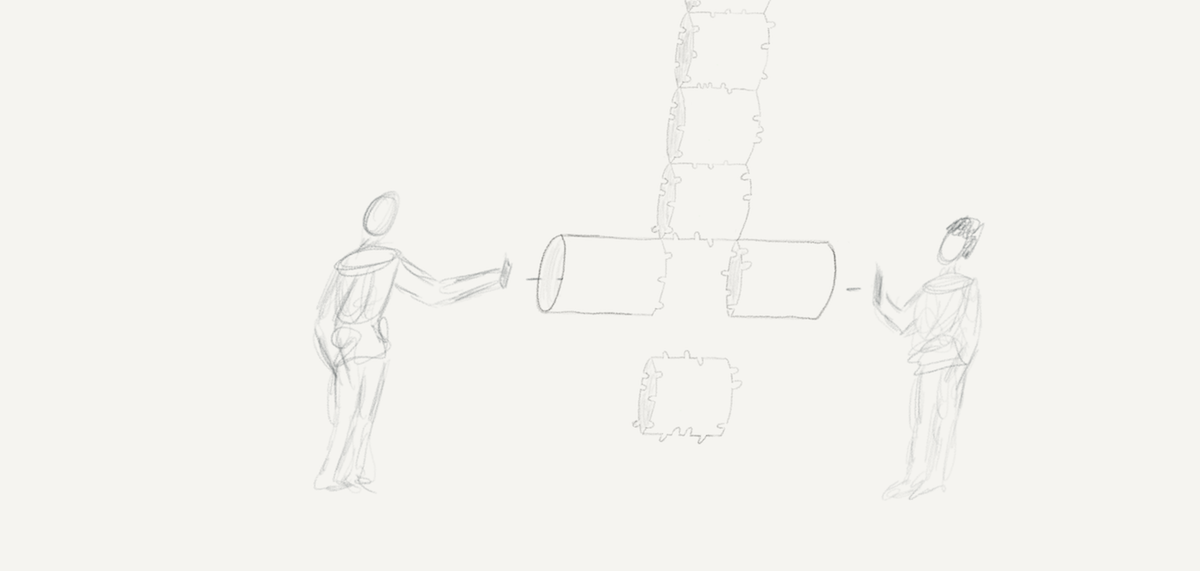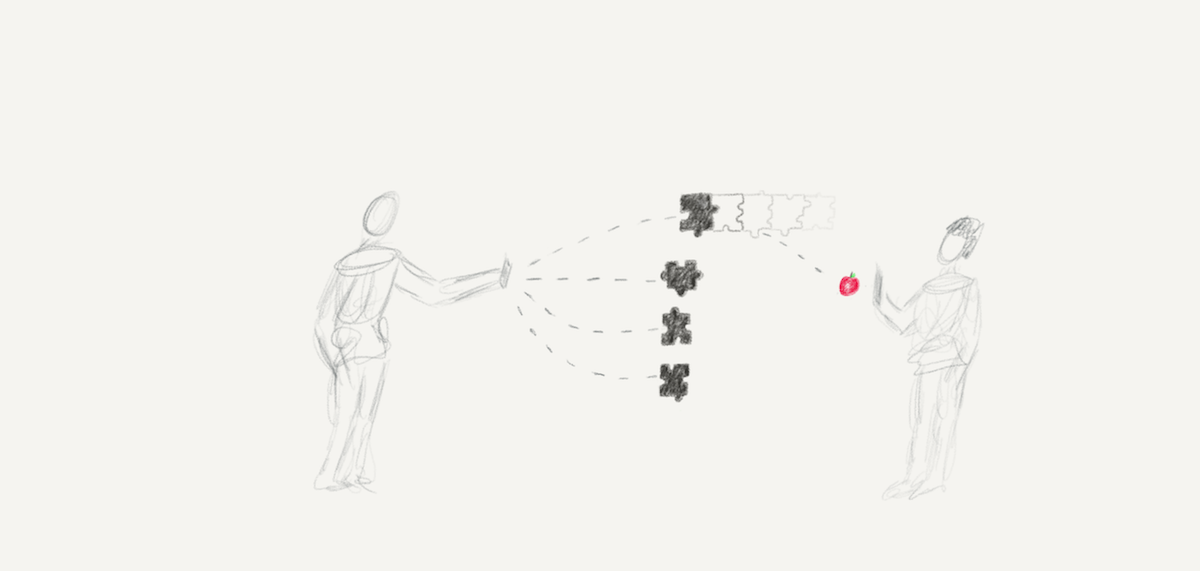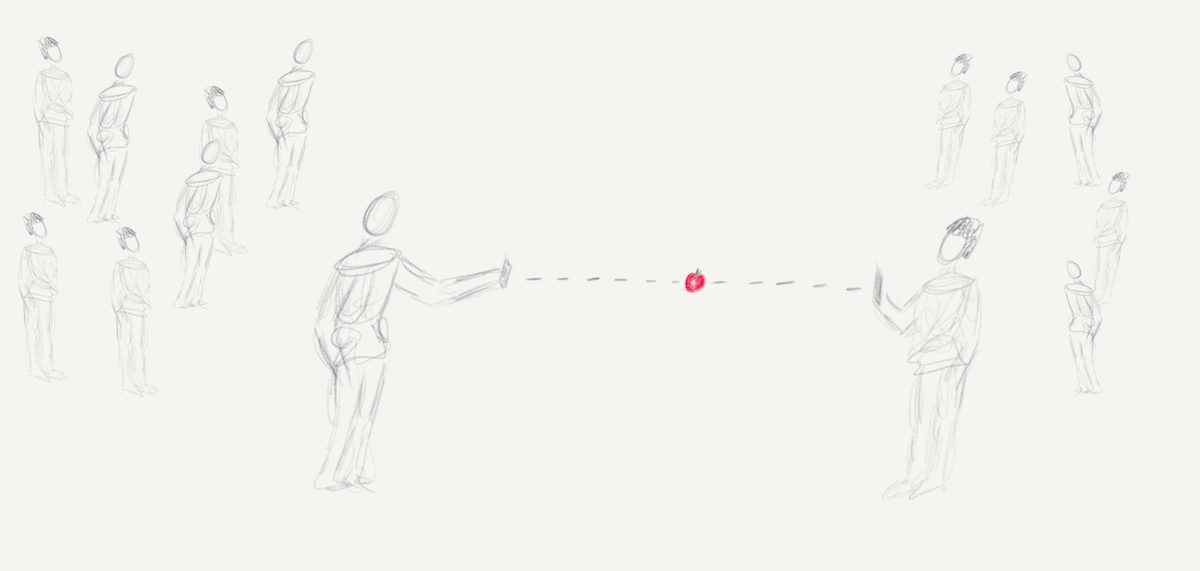Blockchain is an interesting topic because of its far-reaching and transformative implications. But what is Blockchain really? Beyond the promises, Bitcoin, Ethereum, the equations, this non-technical explanation has the aim of providing an intuitive understanding.
Giving physically is easy
We are used to the ease of giving physical objects directly. This simple action comprises a lot of aspects that we take for granted, but which are essential for the transaction.
Giving digitally is harder than you think
Giving something digitally is different because there is distance between sender and recipient. The systems for making the transaction happen are complex and not transparent. How do you know what exactly is happening?
The internet is a set of pipes
There are many different types of pipes. Some are transparent and anyone can look what’s going through. Others go to other countries before coming back to your co-worker sitting next to you.
Many important aspects to transactions are not clearly assured, leading to questions that don’t arise when giving physically.
For the sender:
– Is it really her?
– Did she receive it?
– Is it arrived as I sent it?
– Should I send it again?
– Will she answer?
For the recipient:
– Who sent this?
– Is this apple real?
– Are there any worms?
– Is this all?
– Should I answer?
Even state-of-the-art methods aren’t always enough
Encryption, certification, backup, checksum, anti-virus, etc. answer many of the questions, but not all of them.
For the sender:
– Is it really her?
– Did she receive it?
– Is it arrived as I sent it?
– Should I send it again?
– Will she answer?
For the recipient:
– Who sent this?
– Is this apple real?
– Are there any worms?
– Is this all?
– Should I answer?
Blockchain is a special kind of pipe, trustworthy and programmable
The goal of Blockchain is to provide to digital systems the same trust, clarity, immediateness, and effectiveness of physical transactions. This is achieved with two elements: (1) A clever file-system and (2) independent system maintainers. The first is a system based on creating blocks of transactions in a way that they depend on the previous links, making it exceedingly difficult to copy or tamper. The second is composed of independent third parties that have an incentive (e.g., earning Bitcoin or Ether) that the Blockchain works.
Encrypted = Hidden
Every transaction is encrypted using the public-key system, hiding the content of the transaction from all but this having the keys. The same system allows also verifying the identity of the sender.
Highly Complex = Exceedingly Difficult for Smaller Tamperers
To add a block of transactions to the Blockchain, a complex puzzle must be solved. Because every block is difficult to replicate on its own and it even depends on the previous blocks, it becomes not feasible to tamper with past transactions because for the system to maintain its consistency all the following blocks should be also solved and finally merged.
Public = Actions on Blocks are Visible
The content of the transactions is invisible to the anyone that doesn’t have the keys, but anyone can look at the blocks of transactions, verify their integrity, the consistency, etc. This means that any malicious modification of the Blockchain can be immediately detected.
Decentralised Redundancy = No Loss
By storing copies in different sites, the information is safe even if one instance is destroyed.
Programmable = Efficient and Transformative
The nature of Blockchain enables each transaction to be associated with small programs that are automatically carried out as soon as a future transaction proves predefined conditions. For instance in real estate there could be smart contracts that transfer title and release escrow when ownership is confirmed, potentially reducing transaction and insurance costs. This characteristic allows Blockchain systems to bypass many intermediaries such as notaries, insurers, banks, etc. The transformative potential cannot be understated.
Giving physically, digitally
The scalability and convenience of digital systems with the trust, clarity, immediateness, and effectiveness of physical transactions. Despite its promises, Blockchain still has technical difficulties to overcome. This doesn’t stop the World’s largest corporations from following the path and see where it may lead. On the way there, it is important to realize that many products and services don’t need full Blockchain solutions. Even the individual characteristics of Blockchain —encryption, redundancy, high-complexity, openness, decentralisation— provide powerful advantages.










